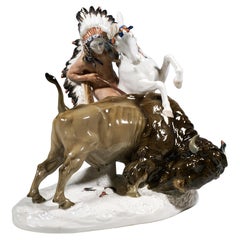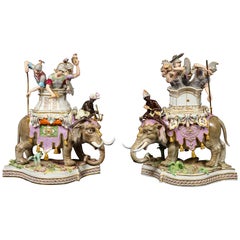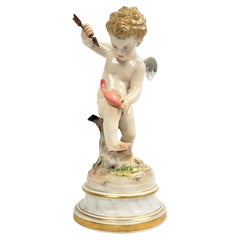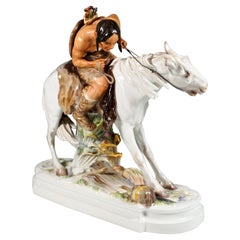Erich Hoesel Figurative Sculptures
1869-1951
Erich Hoesel was, since 1904, professor and leader of the Meissen Modelling Department till 1907 and the headmaster of the Meissen Modelling Department from 1912–29 when he retired.
to
1
1
1
1
1
1
1
1
1
1
Height
to
Width
to
1
1
1
1
154
154
141
112
Creator: Erich Hoesel
Meissen Art Nouveau Porcelain Group 'Indian Haunting A Buffalo', Hoesel, Germany
By Erich Hoesel, Meissen Porcelain
Located in Vienna, AT
Exquisite Large Meissen Art Nouveau Porcelain Group:
Representation of a mounted warrior with a painted face, wearing only a small loincloth and moccasins on his feet, and crowned wi...
Category
1930s German Art Nouveau Vintage Erich Hoesel Figurative Sculptures
Materials
Porcelain
Related Items
Important Meissen Porcelain Groups of Caparisoned Elephants and Soldiers
By Meissen Porcelain
Located in New York, NY
An important pair of Meissen Porcelain Groups depicting "Alexander The Great Concurring India". Modeled with Alexander the great's three warriors/soldiers riding on caparisoned eleph...
Category
1880s German Rococo Antique Erich Hoesel Figurative Sculptures
Materials
Porcelain
$95,800
H 15.5 in W 13.5 in D 6.5 in
Antique Meissen Porcelain Figurine of Cupid Holding an Arrow & Flaming Heart
By Meissen Porcelain
Located in Hamilton, Ontario
This antique figurine was made by the renowned Meissen factory of Germany is approximately 1850 in the period Dresden style. The figurine is done in early paste porcelain and depicts a cherub, or Cupid seated on a stump, holding an arrow with an outstretched hand, and cradling a flaming heart...
Category
Mid-19th Century German Romantic Antique Erich Hoesel Figurative Sculptures
Materials
Porcelain
$799
H 7.75 in Dm 3.75 in
Early Meissen Porcelain, Singerie Style Monkey Musician Figurine
By Meissen Porcelain
Located in New York, NY
An early Meissen Porcelain Singerie style Monkey Musician Figurine. Dressed in full male noble attire and wig the monkey merrily plays the trumpet assu...
Category
19th Century German Rococo Antique Erich Hoesel Figurative Sculptures
Materials
Porcelain
Meissen Porcelain Cubist French Horn Musician Figurine by Peter Strang
By Peter Strang, Meissen Porcelain
Located in Philadelphia, PA
A fine vintage Meissen porcelain figurine.
By Peter Strang. Strang was born in Dresden in 1935 and received a degree in Sculpture from the Academy of F...
Category
20th Century German Erich Hoesel Figurative Sculptures
Materials
Porcelain
Rare 18th Century Meissen Porcelain Group of a Thalia with a Harlequin Child
By J.J. Kändler, Meissen Porcelain
Located in New York, NY
An important, extremely rare, and rather large 18th century Meissen Porcelain Group of a Thalia with a Harlequin Child, By Johann Joachim (J.J.) Kändler, Circa: 1744. This is an incredible and extremely rare 18th century Meissen Porcelain piece modeled by the greatest Meissen modeler ever in the Company, Johann Joachim (J.J.) Kändler.
Thalia can be seen seated on a gorgeous hand-carved and hand-painted flowered and vined porcelain pedestal. Her right arm is raised holding a Phantom of the Opera Black and White Mask, while in her other arm is a young Harlequin dancing and singing holding a hat. Thalia is wearing a gilt-edged dark blue bodice with white floral decorations over a black corset draped in a red-over-yellow robe...
Category
18th Century German Rococo Antique Erich Hoesel Figurative Sculptures
Materials
Porcelain
$126,600
H 17 in W 11.5 in D 8 in
A Monumental Meissen Porcelain Figural Group of Mount Parnassus
By Meissen Porcelain
Located in Brighton, West Sussex
A Monumental Meissen Porcelain Figural Group of Apollo and the Nine Muses on Mount Parnassus.
Comprised of sixteen interlocking parts. Apollo standing holding a lyre and with Pegasus besides a tree, atop a rocky outcrop detailed with foliage and waterfalls above nine goddesses:
Calliope, seated and shown writing, representing eloquence and epic poetry.
Clio, seated with an open book and blowing a trumpet, representing history.
Erato, seated and holding a kithara, representing science and the arts
Euterpe, seated and holding a flute, representing music.
Melpomene, seated holding a knife and with one hand to her head, representing tragedy.
Thalia, seated and holding aloft mask, representing comedy and idyllic poetry.
Urania, seated with telescope and globe, representing astronomy and astrology,
Polyhymnia, standing with one hand raised and holding a book, representing sacred poetry.
Terpsichore, standing, representing dance.
Each piece exceptionally finely detailed and painted. The base portions with rocaille edges. On a later black polished wooden base.
Multiple blue crossed swords marks. Each piece titled to underside.
German, Circa 1880.
Mount Parnassus, is a spur of the Pindus Mountains in central Greece and was sacred to the ancient Greeks and in mythology to Apollo, the god of music and poetry and of the Sun and light. Mount Parnassus the mythical centre of poetry, music, and learning in ancient Greece was a popular theme in Barqoue and Rococo art, often substitutable with Athena’s arrival at Mount Helicon from the fifth book of Ovid’s “Metamorphoses”, where she asks the Muses to show her the new spring which gushed forth from the spot where Pegasus “with his hoof of horn opened the earth” (V, 250-260).
Here, the mountain, formed from rugged rock cliffs, culminates in a plateau on which the youthful Apollo stands and plays the lyre. The Castalian spring flows from beneath Pegasus’ hoof, representing the source of inspiration and attracting the nine muses, who embody the arts and inspire creation through song, music, and dance.
Mount Parnassus was created at the Meissen porcelain manufactory as a table centrepiece and an earlier version, apparently with only five muses, is listed in the inventory of the pastry shop of the Meissen manufactory manager and cabinet minister Heinrich Graf Brühl in 1753. The storage in the pastry shop of approximately 3,000 objects and dishes, including many individual parts for centrepieces, is related to their function as table decorations, replacing decorations previously made by the confectioner from perishable materials such as sugar or wax.
The purpose of this table decoration was as a feast for the eyes to accompany the feast of the banquet. The sculptural figurines often depicted a particular theme, with characters drawn from theatre and opera, from classical mythology or pastoral idylls. Allegories and mythological themes, such as the glorification of fine arts, were also popular. Stylistically, Mount Parnassus fits Kändler’s style of the 1740s, and was sold by Brühl in 1762 to Frederick the Great of Prussia who used mythology as a means of self-expression and had already ordered individual figures of Apollo and the Muses as table decorations in 1744. Today it is in the Museum of Applied Arts, Frankfurt (inv. no. M.L. 41). There is another version of Mount Parnassus, from the collection of Prince Alexander Dolgorukoff, in the Hermitage in Saint Petersburg.
The present version dates to the second half of the nineteenth century when there was a great revival of Kändler rococo figurines which were reissued and a “Second Rococo”. Another nineteenth century example is in the collection of the Museo Francesco Borgogna, Italy (inv. 1906, XIII, 19-20). These nineteenth century versions were made by the Meissen factory using Kändler's period models. It is recorded that a new version of Mount Parnassus, dating to the 1880s, was part of the Royal Porcelain collection in Dresden:
'In the porcelain collection there is a new version from the 1880s based on the old models, the largest group of this genre, the Parnassus, which shows the named muses all around on the lower part of the rock, each practising their own art, while on the top there is Apollo with the lyre and next to it the Castalian spring rises from the hoofbeat of Pegasus. Each figure is executed individually with its rocky background, and all the pieces are then fitted together, as we have already seen in his earlier, larger compositions. The rock pieces are finished off like a pedestal at the bottom with Rococo ornaments.' (Jean Louis Sponsel, Kabinettstücke der Meissner Porzellan-manufaktur von Johann Joachim Kändler, Leipzig, 1900, pp. 203-204).
Kunst und kunsthandwerk; monatsschrift herausgegeben vom Österreichischen museum fuer kunst und industrie, Vienna, 1894, v.7 pt.1, p.133.
Kari Berling, Das Meißner Porzellan und seine Geschichte. Leipzig 1900, S. 99, 187-200.
Helmuth Gröger, Johann Joachim Kaendler. Dresden, 1956.
Peter W Meister, Franz Adrian Dreier, Figürliche Keramik aus zwei Jahrtausenden. Kat Museum für Kunsthandwerk, Frankfurt. Frankfurt 1964, Nr. 90.
Rainer Rückert, Meißener Porzellan, 1710-1810. Kat. Ausst. Bayerisches Nationalmuseum München. München 1966.
Stefan Bursche, Tafelzier des Barock. München 1974, Abb. 300.
"Tafelaufsatz, Der Parnass", Auswahlkatalog, Museum für Kunsthandwerk (Frankfurt am Main, Germany), 1987, pp. 86-87.
Alfred Ziffer, ‘Meissener Porzellanplastik für fürstliches Interieur und Zeremoniell’, Keramos, Issue 241/242, pp. 29–52.
MEISSEN
The production of Meissen porcelain began in 1710 at the manufactory at Meissen...
Category
19th Century German Rococo Antique Erich Hoesel Figurative Sculptures
Materials
Porcelain
$266,386
H 26.78 in W 36.23 in D 24.02 in
19th Century Meissen Porcelain Figure of a Malabar Man on a Rhinoceros
By Meissen Porcelain
Located in New York, NY
A fantastic 19th century Meissen Porcelain orientalist/Turkish figure of a Malabar Man seated on a rhinoceros. This is a rare and beautiful group made by...
Category
19th Century German Chinoiserie Antique Erich Hoesel Figurative Sculptures
Materials
Porcelain
$15,800
H 10 in W 10 in D 4.5 in
Pair of Porcelain Parrots Signed Meissen, Germany, Early 20th Century
By Meissen Porcelain
Located in Buenos Aires, Buenos Aires
Pair of porcelain parrots signed Meissen. Germany, early 20th century.
Category
Early 20th Century German Belle Époque Erich Hoesel Figurative Sculptures
Materials
Porcelain
$8,000 Sale Price / set
20% Off
H 9.06 in W 5.91 in D 4.34 in
A Pair Of Meissen Porcelain Mythological Figural Groups
By Meissen Porcelain
Located in Brighton, West Sussex
A Pair Of Meissen Porcelain Mythological Figural groups, of 'Neptune and Thetis' and 'The Triumphal Procession of Amphitrite'.
'Neptune and Thetis' modelled with the god of the sea ...
Category
19th Century German Rococo Antique Erich Hoesel Figurative Sculptures
Materials
Porcelain
Meissen, Germany. "Pink Indian" porcelain coffee pot.
Located in København, Copenhagen
Meissen, Germany.
A "Pink Indian" porcelain coffee pot.
Hand-painted with purple floral motifs, gold rim.
Lid with flower bud in relief.
Mid-20th century.
Marked.
Third factory quali...
Category
Mid-20th Century German Erich Hoesel Figurative Sculptures
Materials
Porcelain
Pair Meissen Porcelain Pug Dog Figures With Pup After J.J.Kaendler
By Meissen Porcelain
Located in Bridgeport, CT
A beautiful pair of heavy Meissen porcelain figures of Pug Dogs with gilt bell collars on blue ribbons.The larger Pug with attached pup. Exquisitely hand-painted with realistic tones and colors. Each Pug is wearing a vibrant blue color ribbon collar...
Category
20th Century Regency Erich Hoesel Figurative Sculptures
Materials
Porcelain
$6,200 / set
H 7 in W 6.5 in D 4.5 in
Meissen Porcelain Revelry Groups
By Meissen Porcelain
Located in New Orleans, LA
This charming pair of Meissen porcelain figures celebrates the essence of Revelry. First modeled by the renowned Johann Joachim Kändler on bases by Peter Reinicke, circa 1767, these joyous groups depict musicians making merry by playing the French horn, flute, guitar and hurdy-gurdy, and gardeners carrying flowers in baskets and aprons. Two almost identical groups are featured in Meissen: Collector’s Catalogue by Laurence Mitchell.
Figures by Kändler were especially popular and served as table decorations at courtly banquets. He took the reigns of the Meissen factory in 1733 and over the following 40 years created more than 900 models, many of which were considered the most important and beautiful ever produced. Many of his designs were so timeless and classic that they continued to be used well into the 19th century. Kändler was highly regarded especially for his allegorical representations and he was certainly at his best when designing the Four Continents...
Category
Late 19th Century French Rococo Antique Erich Hoesel Figurative Sculptures
Materials
Porcelain
Previously Available Items
Art Nouveau Porcelain Group 'Hun On Horseback', by E. Hoesel, Meissen Germany
By Erich Hoesel, Meissen Porcelain
Located in Vienna, AT
Exquisite Large Meissen Art Nouveau Porcelain Group:
Depiction of a mounted warrior, armed with shield and bow on his back, leaning from his horse to ...
Category
Early 1900s German Art Nouveau Antique Erich Hoesel Figurative Sculptures
Materials
Porcelain
H 12.01 in W 13 in D 5.52 in
Erich Hoesel figurative sculptures for sale on 1stDibs.
Erich Hoesel figurative sculptures are available for sale on 1stDibs. These distinctive items are frequently made of porcelain and are designed with extraordinary care. There are many options to choose from in our collection of Erich Hoesel figurative sculptures, although brown editions of this piece are particularly popular. Many of the original figurative sculptures by Erich Hoesel were created in the Art Nouveau style in germany during the 1930s. If you’re looking for additional options, many customers also consider figurative sculptures by Paul Helmig, Ferdinand Liebermann, and WMF Württembergische Metallwarenfabrik. Prices for Erich Hoesel figurative sculptures can differ depending upon size, time period and other attributes — on 1stDibs, these items begin at $7,114 and can go as high as $7,114, while a piece like these, on average, fetch $7,114.
Creators Similar to Erich Hoesel
WMF Württembergische Metallwarenfabrik



